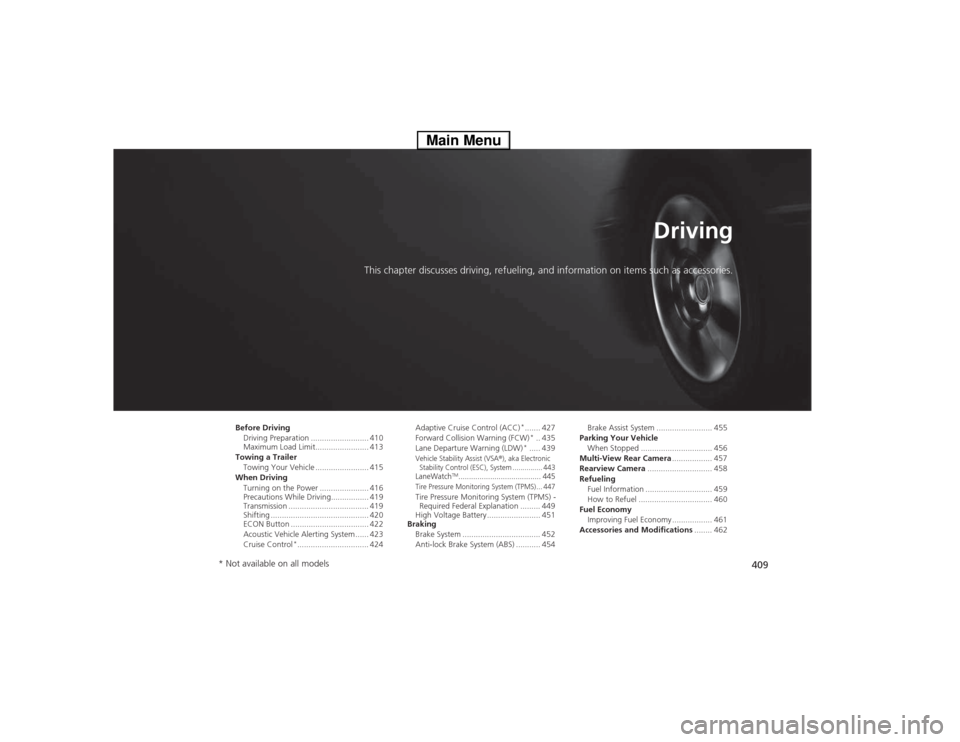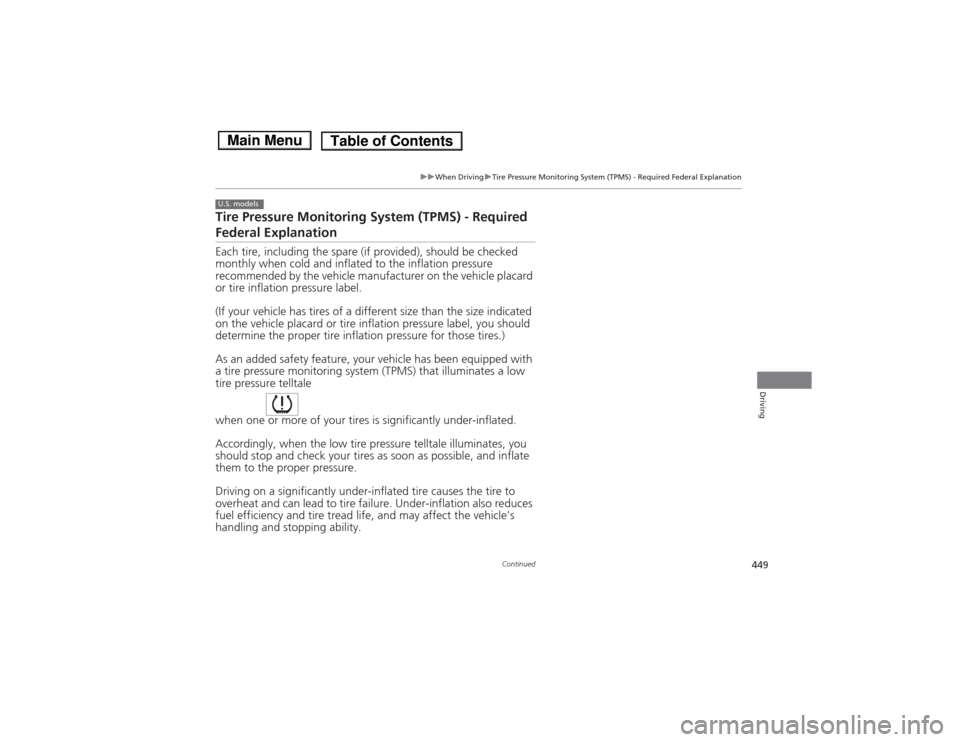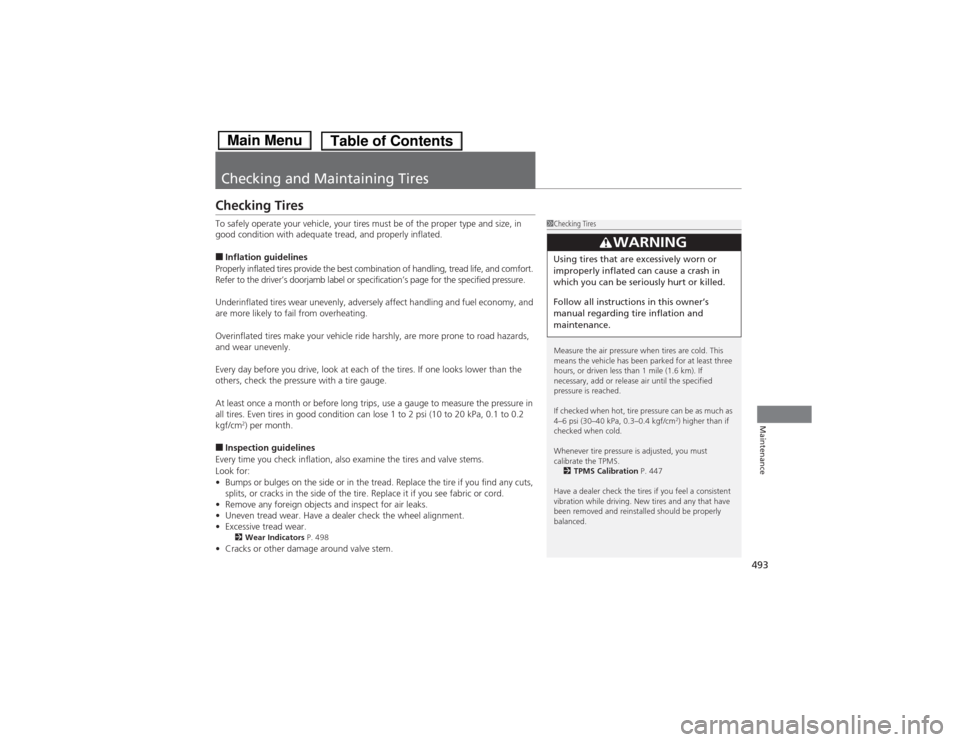2014 HONDA ACCORD HYBRID fuel pressure
[x] Cancel search: fuel pressurePage 17 of 561

16
Quick Reference Guide
Instrument Panel (P 71)
CanadaU.S.
Low Fuel Indicator
Anti-lock Brake
System ( ABS)
Indicator
Parking Brake
and Brake System
Indicator (Red)
Canada U.S.
READY Indicator
System Indicators
Malfunction
Indicator Lamp
Low Oil Pressure
Indicator
12-Volt Battery
Charging System
Indicator
Vehicle Stability
Assist (VSA ®) System
Indicator VSA ® OFF Indicator
Low Tire Pressure/
TPMS Indicator
Electric Power
Steering (EPS) System
Indicator
Lights IndicatorsLights On Indicator
High Beam Indicator
Immobilizer System
Indicator
Seat Belt Reminder
Indicator EV Indicator
POWER
/CHARGE
Gauge Speedometer
Fuel Gauge
Security System
Alarm Indicator
Shift Lever Position
Indicator
Gauges
(P 92)/Multi-Information Display (P 94)/System Indicators (P 72)
Turn Signal and
Hazard Warning
Indicators
System Indicators High Voltage Battery
Charge Level Gauge
POWER SYSTEM
Indicator
Smart Entry System
Indicator System Message
Indicator
ECON mode
Indicator
Forward Collision
Warning (FCW) Indicator*
Lane Departure Warning (LDW) Indicator* Brake System
Indicator (Amber)
Supplemental
Restraint System
IndicatorEV
Mode Indicator
System Indicators
Multi-Information Display
Main Menu
Page 410 of 561

409
Driving
This chapter discusses driving, refueling, and information on items such as accessories.
Before Driving Driving Preparation .......................... 410
Maximum Load Limit........................ 413
Towing a Trailer Towing Your Vehicle ........................ 415
When Driving Turning on the Power ...................... 416
Precautions While Driving................. 419
Transmission .................................... 419
Shifting ............................................ 420
ECON Button ................................... 422
Acoustic Vehicle Alerting System ...... 423
Cruise Control *
................................ 424 Adaptive Cruise Control (ACC)
*
....... 427
Forward Collision Warning (FCW) *
.. 435
Lane Departure Warning (LDW) *
..... 439
Vehicle Stability Assist (VSA®), aka Electronic
Stability Control (ESC), System ............... 443
LaneWatchTM....................................... 445Tire Pressure Monitoring System (TPMS) ... 447Tire Pressure Monitoring System (TPMS) -
Required Federal Explanation ......... 449
High Voltage Battery ........................ 451
Braking
Brake System ................................... 452
Anti-lock Brake System (ABS) ........... 454 Brake Assist System ......................... 455
Parking Your Vehicle
When Stopped ................................ 456
Multi-View Rear Camera .................. 457
Rearview Camera ............................. 458
Refueling Fuel Information .............................. 459
How to Refuel ................................. 460
Fuel Economy Improving Fuel Economy .................. 461
Accessories and Modifications ........ 462
* Not available on all models
Main Menu
Page 450 of 561

449
uuWhen DrivinguTire Pressure Monitoring System (TPMS) - Required Federal Explanation
Continued
Driving
Tire Pressure Monitoring System (TPMS) - Required
Federal Explanation
Each tire, including the spare (if provided), should be checked
monthly when cold and inflated to the inflation pressure recommended by the vehicle manufacturer on the vehicle placard
or tire inflation pressure label.
(If your vehicle has tires of a different size than the size indicated
on the vehicle placard or tire inflation pressure label, you should
determine the proper tire inflation pressure for those tires.)
As an added safety feature, your vehicle has been equipped with a tire pressure monitoring system (TPM S) that illuminates a low
tire pressure telltale
when one or more of your tires is significantly under-inflated.
Accordingly, when the low tire pressure telltale illuminates, you
should stop and check your tires as soon as possible, and inflate them to the proper pressure.
Driving on a significantly under-inflated tire causes the tire to
overheat and can lead to tire fail ure. Under-inflation also reduces
fuel efficiency and tire tread life, and may affect the vehicle's
handling and stopping ability.
U.S. models
Main MenuTable of Contents
Page 462 of 561

461
Driving
Fuel Economy
Improving Fuel Economy
Fuel economy depends on several conditions, including driving conditions, your
driving habits, the condition of your vehicle, and loading. Depending on these and
other conditions, you may or may not achieve the rated fuel economy of this vehicle.
You can optimize your fuel economy with proper maintenance of your vehicle.
Always maintain your vehicle in accordance with the messages displayed on the multi-information display. • Use the recommended viscosity engine oil, displaying the API Certification Seal.
• Maintain the specified tire pressure.
• Do not load the vehicle with excess cargo.
• Keep your vehicle clean. A buildup of snow or mud on your vehicle's underside
adds weight and increases wind resistance.
■Maintenance and Fuel Economy
1Improving Fuel Economy
Direct calculation is the recommended method to
determine actual fuel consumed while driving.
In Canada, posted fuel economy numbers are
established following a simulated test. For more
information on how this test is performed, please visit
http://oee.nrcan.gc.ca/
Miles driven Gallons of
fuel Miles per
Gallon
100 Liter Kilometers L per 100 km
Main MenuTable of Contents
Page 465 of 561

464
Maintenance
Before Performing Maintenance
Inspection and Maintenance
For your safety, perform all listed inspections and maintenance to keep your vehicle
in good condition. If you become aware of any abnormality (noise, smell, insufficient
brake fluid, oil residue on the ground, etc.), have your vehicle inspected by a dealer.
(Note, however, that service at a dealer is not mandatory to keep your warranties in
effect.) Refer to the separate maintenance booklet for detailed maintenance and inspection information. ■Daily inspections
Perform inspections before long distance trips, when washing the vehicle, or when refueling. ■ Periodic inspections
• Check the brake fluid level monthly.
2 Brake Fluid P. 482
• Check the tire pressure monthly. Examine the tread for wear and foreign objects.
2 Checking and Maintaining Tires P. 493
• Check the operation of the exterior lights monthly.
2 Replacing Light Bulbs P. 484
• Check the condition of the wiper blades at least every six months.
2 Checking and Maintaining Wiper Blades P. 491
■Types of Inspection and Maintenance
1Inspection and Maintenance
Maintenance, replacement, or repair of
emissions control devices and systems may be
done by any automotive repair establishment or
individuals using parts that are “certified” to EPA standards.
According to state and federal regulations, failure to
perform maintenance on the maintenance main
items marked with # will not void your emissions
warranties. However, all maintenance services should
be performed in accordance with the intervals
indicated by the multi-information display.
2 Maintenance Service Items P. 469
If you want to perform complex maintenance tasks
that require more skills and tools, you can purchase a
subscription to the Service Express website at
www.techinfo.honda.com .
2 Authorized Manuals P. 547
If you want to perform maintenance yourself, make
sure that you have the necessary tools and skills first.
After performing maintenance, update the records in
the separate maintenance booklet.
U.S. models
Main MenuTable of Contents
Page 494 of 561

493
Maintenance
Checking and Maintaining Tires
Checking Tires
To safely operate your vehicle, your tires must be of the proper type and size, in
good condition with adequate tread, and properly inflated. ■Inflation guidelines
Properly inflated tires provide the best combination of handling, tread life, and comfort. Refer to the driver’s doorjamb label or sp ecification’s page for the specified pressure.
Underinflated tires wear unevenly, adversely affect handling and fuel economy, and
are more likely to fail from overheating.
Overinflated tires make your vehicle ride harshly, are more prone to road hazards, and wear unevenly.
Every day before you drive, look at each of the tires. If one looks lower than the
others, check the pressure with a tire gauge.
At least once a month or before long trips, use a gauge to measure the pressure in
all tires. Even tires in good condition can lose 1 to 2 psi (10 to 20 kPa, 0.1 to 0.2
kgf/cm 2
) per month.
■ Inspection guidelines
Every time you check inflation, also examine the tires and valve stems.
Look for: • Bumps or bulges on the side or in the tread. Replace the tire if you find any cuts,
splits, or cracks in the side of the tire. Replace it if you see fabric or cord.
• Remove any foreign objects and inspect for air leaks.
• Uneven tread wear. Have a dealer check the wheel alignment.
• Excessive tread wear.
2 Wear Indicators P. 498
• Cracks or other damage around valve stem.
1Checking Tires
Measure the air pressure when tires are cold. This
means the vehicle has been parked for at least three
hours, or driven less than 1 mile (1.6 km). If
necessary, add or release air until the specified
pressure is reached.
If checked when hot, tire pressure can be as much as
4–6 psi (30–40 kPa, 0.3–0.4 kgf/cm 2
) higher than if
checked when cold.
Whenever tire pressure is adjusted, you must
calibrate the TPMS.
2 TPMS Calibration P. 447
Have a dealer check the tires if you feel a consistent
vibration while driving. New tires and any that have
been removed and reinstalled should be properly balanced.
3WARNING
Using tires that are excessively worn or
improperly inflated can cause a crash in
which you can be seriously hurt or killed.
Follow all instruction s in this owner’s
manual regarding tire inflation and
maintenance.
Main MenuTable of Contents
Page 553 of 561

Index
552
Index
Index
Numbers
12-Volt Battery Charging System Indicator ............................................ 74, 528
A
ABS (Anti-lock Brake System) ................... 454
Accessories and Modifications ................. 462
Accessory Power Sockets .......................... 160
Acoustic Vehicle Alerting System ............ 423
Adaptive Cruise Control (ACC) ................. 427
Additives
Coolant ........................................... 478, 480
Engine Oil ................................................ 473
Washer .................................................... 483
Additives, Engine Oil ................................ 473
Adjusting Armrest ................................................... 154
Clock ....................................................... 110
Front Seats .............................................. 148
Head Restraints........................................ 151
Mirrors .................................................... 146
Steering Wheel ........................................ 145
Temperature .............................................. 97
Aha TM
Radio ...................................... 224, 277
Air Conditioning System (Climate Control System) .................................................... 165
Changing the Mode ................................ 165
Defrosting the Windshield and Windows ............................................... 166
Dust and Pollen Filter ............................... 504 Recirculation/Fresh Air Mode .....
.............. 165
Sensors ................................................... 168
Synchronized Mode................................. 167
Using Automatic Climate Control ............ 165
Air Pressure ....................................... 494, 539
Airbags ........................................................ 43
Advanced Airbags ..................................... 49
After a Collision ........................................ 46
Airbag Care............................................... 55
Event Data Recorder .................................. 29
Front Airbags (SRS) .................................... 46
Indicator.............................................. 53, 76
Passenger Airbag Off Indicator .................. 54
Sensors ..................................................... 43
Side Airbags .............................................. 50
Side Curtain Airbags.................................. 52
AM/FM Radio ............................ 182, 208, 247
Anti-lock Brake System (ABS) .................. 454
Indicator.................................................... 76
Armrest ..................................................... 154
Audio Remote Controls ........................... 174
Audio System ............................................ 170
Adjusting the Sound................ 180, 206, 237
Auxiliary Input Jack.................................. 172
Error Messages ........................................ 283
General Information ................................ 289
HDD ........................................................ 257
Internet Radio ......................... 190, 222, 275
iPod ........................................ 187, 218, 267
MP3/WMA/AAC ...................... 192, 225, 278
Reactivating ............................................ 173 Recommended CDs ................................ 290
Recommended Devices ........................... 292
Remote Controls ..................................... 174
Security Code ......................................... 173
Theft Protection ...................................... 173
Touch Screen .................................. 198, 231
USB Flash Drives...................................... 292
USB Port ................................................. 171
Authorized Manuals ................................ 547
Auto Door Locking/Unlocking ................ 121
Customize .............................. 106, 304, 322
Automatic Lighting .................................. 137
Auxiliary Input Jack ................................. 172
Average Fuel Economy .............................. 96
Average Fuel Economy Records ................ 98
Average Speed ........................................... 97
B
Battery .................................................. 8, 502
12-Volt ................................................... 502
12-Volt Battery Charging System Indicator ................................................. 74
Charging (12-Volt Battery) ...... ................ 502
High Voltage....................................... 8, 451
Jump Starting ......................................... 522
Maintenance (Checking the 12-Volt
Battery) ................................................. 502
Maintenance (Replacing the Button
Battery) ................................................. 503
Belts (Seat) .................................................. 36
Main Menu
Page 555 of 561

554
Index
Doors......................................................... 112
Auto Door Locking .................................. 121
Auto Door Unlocking ............................... 121
Door and Trunk Open Message ................. 35
Keys ........................................................ 112
Locking/Unlocking the Doors from the Inside ............................................... 118
Locking/Unlocking the Doors from the Outside ............................................ 114
Lockout Prevention System ...................... 117
DOT Tire Quality Grading ........................ 496
Driving ....................................................... 409
Adaptive Cruise Control (ACC) ................ 427
Braking .................................................... 452
Cruise Control ......................................... 424
Shifting.................................................... 420
Transmission ............................................ 419
Turning on the Power .............................. 416
Driving Position Memory System ............. 143
Dust and Pollen Filter ............................... 504
E
Eco Assist System ........................................ 13
Eco Drive Display ........................................ 14
ECON Button ............................................. 422
Elapsed Time ............................................... 96
Electric Power Steering (EPS) System Indicator ............................................ 78, 530
Electronic Stability Control (ESC) ............. 443
Emergency ................................................. 535 Emergency Trunk Opener
........................ 125
Emissions Testing (Readiness Codes) ....... 543
Engine ....................................................... 540
Coolant ................................................... 478
Jump Starting .......................................... 522
Oil ........................................................... 473
Engine Coolant
Adding to the Engine Coolant Reservoir ............................................... 478
Adding to the Radiator ......... ............... .... 479
Overheating ............................................ 525
Engine Oil ................................................. 473
Adding .................................................... 475
Checking................................................. 474
Displaying Oil Life .................................... 467
Low Oil Pressure Indicator ................. 74, 528
Recommended Engine Oil ....................... 473
EPS (Electric Power Steering)
System ............................................... 78, 530
EV Button .................................................... 10
EV Indicator ................................................ 73
Exhaust Gas Hazard (Carbon
Monoxide) ................................................. 68
Expanded View Driver’s Mirror ............... 147
Exterior Care (Cleaning) ........................... 507
Exterior Mirrors ........................................ 147
F
Features .................................................... 169 Filters
Dust and Pollen....................................... 504
Oil .......................................................... 476
Flat Tire ..................................................... 510
Floor Mats ................................................ 506
Fluids Brake ...................................................... 482
Engine Coolant ....................................... 478
Inverter Coolant ...................................... 480
Transmission ........................................... 481
Windshield Washer ................................. 483
Foot Brake ................................................ 453
Forward Collision Warning (FCW) .......... 435
Front Airbags (SRS) .................................... 46
Front Seats ................................................ 148
Adjusting ................................................ 148
Fuel ..................................................... 24, 459
Economy................................................. 461
Gauge ...................................................... 92
Instant Fuel Economy ................................ 97
Low Fuel Indicator..................................... 76
Range ....................................................... 96
Recommendation.................................... 459
Refueling ................................................ 459
Fuel Economy ........................................... 461
Fuel Fill Cap ........................................ 24, 460
Message ................................................. 529
Fuel Fill Door ...................................... 24, 460
Fuses ......................................................... 532
Inspecting and Changing ........................ 534
Locations ........................................ 532, 533
Main Menu